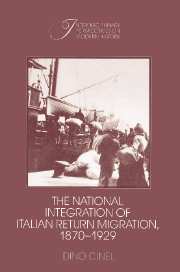Book contents
- Frontmatter
- Contents
- Acknowledgments
- Introduction: Emigration and the process of national integration
- 1 The difficult task of national integration
- 2 A blueprint for change
- 3 The southern ethos
- 4 The national debate
- 5 Return migration
- 6 American remittances
- 7 Investing American savings
- 8 Regional differences
- 9 Return and retirement
- Conclusion: National integration and return migration
- Notes
- Index
Conclusion: National integration and return migration
Published online by Cambridge University Press: 03 December 2009
- Frontmatter
- Contents
- Acknowledgments
- Introduction: Emigration and the process of national integration
- 1 The difficult task of national integration
- 2 A blueprint for change
- 3 The southern ethos
- 4 The national debate
- 5 Return migration
- 6 American remittances
- 7 Investing American savings
- 8 Regional differences
- 9 Return and retirement
- Conclusion: National integration and return migration
- Notes
- Index
Summary
In Italy the early national experience lasted about fifty years. It started in 1870, with the occupation of Rome and the relocation of the Italian government to that city from Florence. It ended in October 1922, when Benito Mussolini marched to Rome with his black shirts. During those five decades Italy went through monumental changes. At times the nation seemed to be on the verge of collapse. For instance, during the 1870s banditry in the south threatened to expand into a fullfledged civil war, with the possible secession of some southern regions from Italy. Similarly, in the early 1890s bank failures and a protracted economic recession with consequent withdrawal of foreign investments in Italy seemed to put an end to the national experience. But the nation survived. And slowly Italy became a modern nation by engaging in the process of integrating its economy and of homogenizing its social and political functions. One can rightly question how successful Italy was in the process. After all, the half century of the national experience ushered in the fascist experiment. And Italian historians still argue as to whether fascism was an aberration of an otherwise sound national development or whether it was the logical outcome of unsound political processes started in 1870. There is no doubt, however, that by 1922 Italy was a more robust and modern nation than in 1870.
During those five decades the public discourse in Italy ranged from foreign investments to Italian military involvement in other countries. It dealt with the tormented relationship between the Vatican and Italy as well as with the role of the government in social and economic matters.
- Type
- Chapter
- Information
- The National Integration of Italian Return Migration, 1870–1929 , pp. 224 - 234Publisher: Cambridge University PressPrint publication year: 1991



